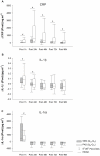Time-course of changes in inflammatory response after whole-body cryotherapy multi exposures following severe exercise
- PMID: 21829501
- PMCID: PMC3145670
- DOI: 10.1371/journal.pone.0022748
Time-course of changes in inflammatory response after whole-body cryotherapy multi exposures following severe exercise
Erratum in
- PLoS One. 2011;6(11). doi:10.1371/annotation/0adb3312-7d2b-459c-97f7-a09cfecf5881. Mounier, Rémi [added]
Abstract
The objectives of the present investigation was to analyze the effect of two different recovery modalities on classical markers of exercise-induced muscle damage (EIMD) and inflammation obtained after a simulated trail running race. Endurance trained males (n = 11) completed two experimental trials separated by 1 month in a randomized crossover design; one trial involved passive recovery (PAS), the other a specific whole body cryotherapy (WBC) for 96 h post-exercise (repeated each day). For each trial, subjects performed a 48 min running treadmill exercise followed by PAS or WBC. The Interleukin (IL) -1 (IL-1), IL-6, IL-10, tumor necrosis factor alpha (TNF-α), protein C-reactive (CRP) and white blood cells count were measured at rest, immediately post-exercise, and at 24, 48, 72, 96 h in post-exercise recovery. A significant time effect was observed to characterize an inflammatory state (Pre vs. Post) following the exercise bout in all conditions (p<0.05). Indeed, IL-1β (Post 1 h) and CRP (Post 24 h) levels decreased and IL-1ra (Post 1 h) increased following WBC when compared to PAS. In WBC condition (p<0.05), TNF-α, IL-10 and IL-6 remain unchanged compared to PAS condition. Overall, the results indicated that the WBC was effective in reducing the inflammatory process. These results may be explained by vasoconstriction at muscular level, and both the decrease in cytokines activity pro-inflammatory, and increase in cytokines anti-inflammatory.
Conflict of interest statement
Figures
References
-
- King M, Duffield R. The effects of recovery interventions on consecutive days of intermittent sprint exercise. J Strength Cond Res. 2009;23:1795–1802. - PubMed
-
- Hirose L, Nosaka K, Newton M, Laveder A, Kano M, et al. Changes in inflammatory mediators following eccentric exercise of the elbow flexors. Exercise immunology review. 2004;10:75–90. - PubMed
-
- Chatzinikolaou A, Fatouros IG, Gourgoulis V, Avloniti A, Jamurtas AZ, et al. Time course of changes in performance and inflammatory responses after acute plyometric exercise. J Strength Cond Res. 2010;24:1389–1398. - PubMed
-
- Clarkson PM, Tremblay I. Exercise-induced muscle damage, repair, and adaptation in humans. J Appl Physiol. 1988;65:1–6. - PubMed
-
- Hellebrandt FA, Houtz SJ. Mechanisms of muscle training in man: experimental demonstration of the overload principle. Phys Ther Rev. 1956;36:371–383. - PubMed
Publication types
MeSH terms
Substances
LinkOut - more resources
Full Text Sources
Medical
Research Materials
Miscellaneous



